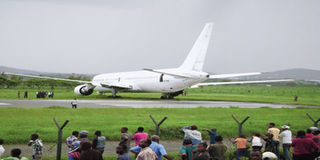Fresh clues on what faced Ethiopia plane

“We were taken by surprise and had no stairs to enable the passengers to disembark. We sought some landing ladders from Swissport at KIA but it took too long. Then we opted for the emergency chutes,”.PHOTO|FILE
What you need to know:
Ms Dede, too, could not explain why the plane, which had 213 passengers and crew on board, was forced to land in Arusha, adding that she was not sure if the crew had sought permission to land from air traffic controllers.
Arusha/Dar es Salaam. Amid questions on what led to an Ethiopian Airlines Boeing 767-300ER landing at Arusha’s tiny airport on Wednesday, experts are weighing the option of extending the runaway to enable the huge jet to fly out.
The airport’s manager, Ms Esther Dede, told The Citizen yesterday that aircraft engineers from Ethiopia and Tanzania were trying to establish whether the plane could take off after it is put back on the runaway from which it skidded as it made an emergency landing.
“If that is not possible then the aircraft will have to be parked and ways sought to extend the runway,” she said as efforts were being made to tow the jet onto the runaway.
The runway at the airport, which is designed to handle light aircraft, is 1,620 metres long. The Boeing 767 needs at least 2,341 metres to take off, according to data on the aviation site www.aircyber.weebly.com.
The largest aircraft currently operating out of the airport is the ATR 42 operated by PrecisionAir.
Ms Dede said special equipment had been brought to the airport to help put the aircraft back on the tarmac.
“We want the aircraft to fly out,” she said, adding that experts were considering removing the fuel and some items on board. The Boeing 767-300ER weighs 81 tonnes when empty. By 4pm yesterday, engineers had put the plane on one end of the runway, but it was not clear when they will attempt to fly it from the airport. A team of six engineers from the aircraft owners in Ethiopia arrived in Arusha yesterday and were joined by others from the Tanzania Civil Aviation Authority (TCAA) and Tanzania Airports Authority (TAA).
The Ethiopians declined to discuss the mishap which happened when the plane landed in Arusha instead of Kilimanjaro International Airport (KIA), some 50 kilometres away.
“Let’s concentrate on how to solve this problem,” a woman in the Ethiopian delegation told The Citizen as heavy machinery was pulling the aircraft onto the tarmac and turning it in the right direction.
Ms Dede, too, could not explain why the plane, which had 213 passengers and crew on board, was forced to land in Arusha, adding that she was not sure if the crew had sought permission to land from air traffic controllers.
“We were taken by surprise and had no stairs to enable the passengers to disembark. We sought some landing ladders from Swissport at KIA but it took too long. Then we opted for the emergency chutes,” she said.
Other sources said the flight originated from Bole Airport in Addis Ababa and was headed to KIA and Mombasa in Kenya with tourists. The transit passengers were taken to some local hotels and were flown to Mombasa and Addis Ababa yesterday.
With the aircraft drama nearing solution, many fingers pointed at the management of KIA for failing to remove a small aircraft that has stalled on the runway, forcing the Ethiopian jet to divert to Arusha airport.
The acting managing director of the Kilimanjaro Airports Development Company (Kadco), which manages the facility, Mr Bakari Murusuri, confirmed that there was a small aircraft on the runway, but was at a loss as to why the pilot decided to land in Arusha.
“Why did they choose to land in Arusha instead of Dar es Salaam, Nairobi or Mombasa? It is safer to land at those airports than in Arusha,” he said.
Arusha Regional Commissioner Magesa Mulongo told The Citizen that the jet had earlier intended to land at KIA, but lost communication and ended up at Arusha airport, which does not handle planes of that size.
In another development, investigators have started probing circumstances which led to the plane crash-landing at Arusha airport.
TCAA said in a statement yesterday that the investigators were drawn from the authority and the Ministry of Transport.
TCAA director general Fadhil Manongi said the jet was supposed to land at KIA, which has a 3,200-metre runaway, at 12.55pm.
Instead, it landed at Arusha airport, whose runway is too short for a Boeing 767.
“Such type of plane requires at least 1,798 metres to land at maximum landing weight,” he said.
But to takeoff, the Boeing 767-300ER requires a runway with a maximum length of 2,341 metres.
Its landing at the Arusha airport led it to cruise the entire length of the runway before skidding and coming to a stop on the grass.




